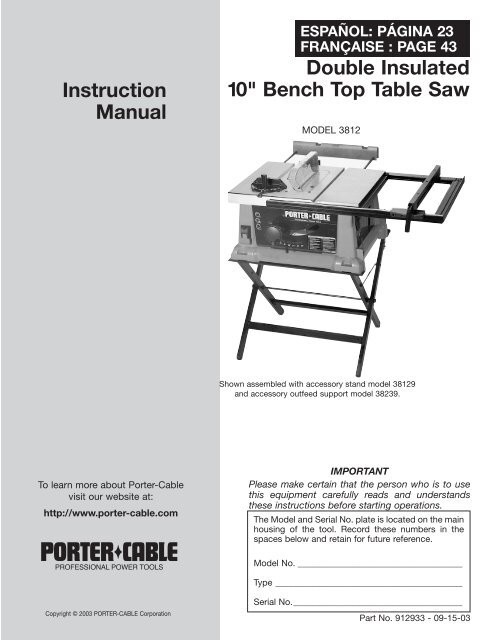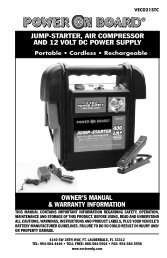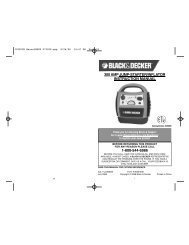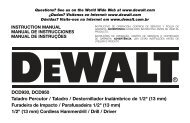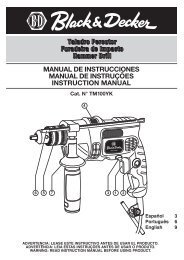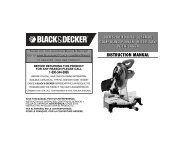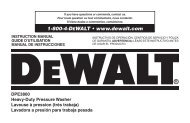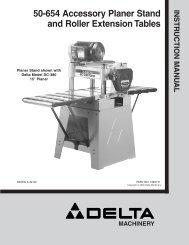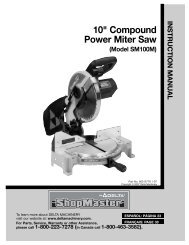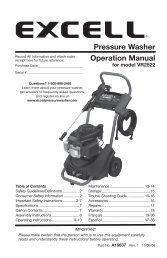Double Insulated 10" Bench Top Table Saw Instruction Manual
Double Insulated 10" Bench Top Table Saw Instruction Manual
Double Insulated 10" Bench Top Table Saw Instruction Manual
- No tags were found...
You also want an ePaper? Increase the reach of your titles
YUMPU automatically turns print PDFs into web optimized ePapers that Google loves.
ADDITIONAL SAFETY RULES FORTABLE SAWSFAILURE TO FOLLOW THESE RULES MAY RESULT IN SERIOUS INJURY.1. DO NOT OPERATE THIS MACHINE until it isassembled and installed according to theinstructions.2. OBTAIN ADVICE FROM YOUR SUPERVISOR,instructor, or another qualified person if you arenot familiar with the operation of this machine.3. FOLLOW ALL WIRING CODES and recommendedelectrical connections.4. USE THE GUARDS WHENEVER POSSIBLE.Check to see that they are in place, secured, andworking correctly.5. AVOID KICKBACK by:A. keeping blade sharp and free of rust and pitch.B. keeping rip fence parallel to the saw blade.C. using saw blade guard and spreader for everypossible operation, including all throughsawing.D. pushing the workpiece past the saw blade priorto release.E. never ripping a workpiece that is twisted orwarped, or does not have a straight edge toguide along the fence.F. using featherboards when the anti-kickbackdevice cannot be used.G. never sawing a large workpiece that cannot becontrolled.H. never using the fence as a guide whencrosscutting.I. never sawing a workpiece with loose knots orother flaws.6. ALWAYS USE GUARDS, SPLITTER, AND ANTI-KICKBACK FINGERS whenever possible.7. REMOVE CUT-OFF PIECES AND SCRAPS fromthe table before starting the saw. The vibration of themachine may cause them to move into the sawblade and be thrown out. After cutting, turn themachine off. After the blade has come to acomplete stop, remove all debris.8. NEVER START THE MACHINE with the workpieceagainst the blade.9. NEVER run the workpiece between the fence and amoulding cutterhead.10. NEVER perform “free-hand” operations. Use eitherthe fence or miter gauge to position and guide theworkpiece.11. HOLD THE WORKPIECE FIRMLY against the mitergauge or fence.12. USE PUSH STICK(S) for ripping a narrowworkpiece.13. AVOID AWKWARD OPERATIONS AND HANDPOSITIONS where a sudden slip could cause ahand to move into the blade.14. KEEP ARMS, HANDS, AND FINGERS away fromthe blade.15. NEVER have any part of your body in line with thepath of the saw blade.16. NEVER REACH AROUND or over the saw blade.17. NEVER attempt to free a stalled saw blade withoutfirst turning the machine “OFF”.18. PROPERLY SUPPORT LONG OR WIDEworkpieces.19. NEVER PERFORM LAYOUT, assembly or set-upwork on the table/work area when the machine isrunning.20. TURN THE MACHINE “OFF” AND DISCONNECTTHE MACHINE from the power source beforeinstalling or removing accessories, before adjustingor changing set-ups, or when making repairs.21. TURN THE MACHINE “OFF”, disconnect themachine from the power source, and clean thetable/work area before leaving the machine. LOCKTHE SWITCH IN THE “OFF” POSITION to preventunauthorized use.22. ADDITIONAL INFORMATION regarding the safeand proper operation of power tools (i.e. a safetyvideo) is available from the Power Tool Institute,1300 Sumner Avenue, Cleveland, OH 44115-2851(www.powertoolinstitute.com). Information is alsoavailable from the National Safety Council, 1121Spring Lake Drive, Itasca, IL 60143-3201. Pleaserefer to the American National Standards InstituteANSI 01.1 Safety Requirements for WoodworkingMachines and the U.S. Department of Labor OSHA1910.213 Regulations.SAVE THESE INSTRUCTIONS.Refer to them oftenand use them to instruct others.4
Use proper extension cords. Make sure your extensioncord is in good condition. When using an extensioncord, be sure to use one heavy enough to carry thecurrent of the machine. An undersized cord will cause adrop in line voltage, resulting in loss of power andoverheating. Fig. D, shows the correct gauge to usedepending on the cord length. If in doubt, use the nextheavier gauge. The smaller the gauge number, theheavier the cord.FOREWORDPOWER CONNECTIONSA separate electrical circuit should be used for your machines. This circuit should not be less than #12 wire and shouldbe protected with a 20 Amp time lag fuse. If an extension cord is used, use only 3-wire extension cords which have 3-prong grounding type plugs and matching receptacle which will accept the machine’s plug. Before connecting themachine to the power line, make sure the switch (s) is in the “OFF” position and be sure that the electric current is ofthe same characteristics as indicated on the machine. All line connections should make good contact. Running on lowvoltage will damage the machine.DO NOT EXPOSE THE MACHINE TO RAIN OR OPERATE THE MACHINE IN DAMP LOCATIONS.POLARIZED PLUGS: To reduce the risk of electric shock, this equipment has a polarized plug (one blade is wider thanthe other). This plug will fit in a polarized outlet only one way. If the plug does not fit fully in the outlet, reverse the plug. If it stilldoes not fit, contact a qualified electrician to install the proper outlet. Do not change the plug in any way.MOTORMany Porter-Cable tools will operate on either D.C., or single phase 25 to 60 cycle A.C. current and voltage within plusor minus 5 percent of that shown on the specification plate of the tool. Several models, however, are designed for A.C.current only. Refer to the specification plate on your tool for proper voltage and current rating.Do not operate your tool on a current where the voltage is not within correct limits. Do not operate toolsrated A.C. on a D.C. current. To do so may seriously damage the tool.REPLACEMENT PARTSWhen servicing, use only identical replacement parts.EXTENSION CORDSMINIMUM GAUGE EXTENSION CORDRECOMMENDED SIZES FOR USE WITH STATIONARY ELECTRIC MACHINESAmpere Total Length Gauge ofRating Volts of Cord in Feet Extension Cord0-6 120 up to 25 18 AWG0-6 120 25-50 16 AWG0-6 120 50-100 16 AWG0-6 120 100-150 14 AWG6-10 120 up to 25 18 AWG6-10 120 25-50 16 AWG6-10 120 50-100 14 AWG6-10 120 100-150 12 AWG10-12 120 up to 25 16 AWG10-12 120 25-50 16 AWG10-12 120 50-100 14 AWG10-12 120 100-150 12 AWG12-16 120 up to 25 14 AWG12-16 120 25-50 12 AWG12-16 120 GREATER THAN 50 FEET NOT RECOMMENDEDFig. DFUNCTIONAL DESCRIPTIONThe Porter-Cable Model 3812 is a 10" <strong>Bench</strong> <strong>Top</strong> <strong>Table</strong> <strong>Saw</strong>. The saw comes with a 26"x20" table surface with a ripfence extension wing which provides a 24½" rip capacity for ripping 4x8 sheets. The Model 3812 comes with a Riptide24 tooth carbide-tipped blade, miter gauge, rip fence, quick release blade guard, and blade changing wrenches.UNPACKING AND CLEANINGCarefully unpack the machine and all loose items from the shipping container. Remove the protective coating from allunpainted surfaces. This coating may be removed with a soft cloth moistened with kerosene (do not use acetone, gasolineor lacquer thinner for this purpose). After cleaning, cover the unpainted surfaces with a good quality household floor pastewax.NOTICE: THE MANUAL COVER PHOTO ILLUSTRATES THE CURRENTPRODUCTION MODEL. ALL OTHER ILLUSTRATIONS ARE REPRESENTATIVEONLY AND MAY NOT DEPICT THE ACTUAL COLOR, LABELING ORACCESSORIES AND MAY BE INTENDED TO ILLUSTRATE TECHNIQUE ONLY.5
CARTON CONTENTS12435 6 789Fig. 21. <strong>Saw</strong>2. Fence3. <strong>Table</strong> Insert4. Blade Guard and Spreader Assembly5. Blade Wrench (2)6. Miter Gauge7. Anchor Block Shim (3)8. Handle9. 1/4"-20x1-3/4" Screw6
ASSEMBLYFOR YOUR OWN SAFETY, DO NOT CONNECT THE MACHINE TO THE POWER SOURCE UNTILTHE MACHINE IS COMPLETELY ASSEMBLED AND YOU READ AND UNDERSTAND THE ENTIREINSTRUCTION MANUAL.BLADE RAISING ANDLOWERING HANDWHEELInsert the 1-3/4" screw (D) Fig. 4, through handle (E).Assemble handle (E) to handwheel (A) by threadingscrew (D) clockwise into handwheel as shown in Fig. 5.Handle (E) should rotate freely on screw (D).DEFig. 4EDABLADE GUARD ANDSPREADER ASSEMBLYFig. 51. DISCONNECT MACHINE FROMPOWER SOURCE.2. THE BLADE GUARD AND SPREADERASSEMBLY MUST BE PROPERLY ALIGNED TO THESAW BLADE IN ORDER TO HELP PREVENTKICKBACK.3. Position the blade 90 degrees to the table and lockin place.BAFig. 64. Insert spreader end (A) Fig. 6, of blade guard intoanchor block (B). Push spreader (A) down into holderuntil you hear a click, indicating that the spreader issecured. NOTE: It is important that the spreader (A) bein the vertical position and pushed straight down into thespreader anchor block (B) during the assemblyprocedure.5. Fig. 7 illustrates the blade guard in place.Fig. 77
6. NOTE: The anchor block (B) Fig. 6, has beenadjusted at the factory so that the spreader will bealigned with the saw blade which is supplied with thesaw. When changing to blades with different widths itmay be necessary to adjust the anchor block (B) Fig. 9,as follows:7. Remove table insert and saw blade.8. Loosen the two screws (C) Fig. 8 (under saw table),that attach the anchor block (B) Fig. 9, to the saw frame(E).9. Three additional shims, two of which are shown at(D) Fig. 9, are supplied with your saw and can be used asrequired between the anchor block (B) and the frame (E)in order to align the spreader with the saw blade.10. After adjustment is completed, tighten the twoscrews (C) Fig. 8.DCFig. 8BREMOVING BLADEGUARD/SPREADERASSEMBLYEDISCONNECT TOOL FROM POWERSOURCE.The blade must be in the 90 degree position to the tablefor the blade guard and spreader assembly to beremoved. Remove the table insert, pull out on thespreader release spring (A) Fig. 9A, while pulling up onthe blade guard/spreader assembly (B). NOTE: STORETHE BLADE GUARD AS SHOWN IN FIG. 31A, WHENTHE BLADE GUARD IS NOT IN USE.MITER GAGEThe miter gage is shipped completely assembled and issupplied with a T-slot miter gage bar (A) Fig. 10, that canbe inserted into either one of the two T-slotted mitergage grooves located in the table top, as shown. The T-slot miter gage can be extended beyond the front of thetable for cross-cutting wide workpieces.MITER GAGE HOLDERFig. 11, illustrates the miter gage (D) inserted into themiter gage holder when not in use.Fig. 9Fig. 9ABAADFig. 10 Fig. 118
RIP FENCE TO SAW TABLE1. The rip fence may be used on the right or left handside of the saw table. Lift locking handle (A) Fig. 12, andposition the front end of the fence on the front fence railas shown.A2. While pressing front end of fence firmly against frontfence rail, place rear end of fence down on the rearfence rail and push down on locking handle (A) Fig. 13,to lock fence in place.Fig. 12FASTENING SAW TO ASUPPORTING SURFACEThe saw MUST be properly secured to a supportingsurface using the four mounting holes, two of which areshown at (A) Fig. 14.THE SUPPORTING SURFACE MUST BEABLE TO SUPPORT 300LBS.Fig. 13AA HOLE MUST BE PROVIDED IN THE SUPPORTINGSURFACE TO FACILITATE SAWDUST FALL-THRUAND REMOVAL. Square the saw on the supportingsurface and mark the location of the four 5/16 inch holesto be drilled, as shown in Fig. 15. Locate and mark an 11or 12 inch square centered between the four mountingholes and cut out and remove the square, as shown inFig. 15. This opening will allow sawdust to fall throughthe saw base. Fasten the saw to the workbench utilizingthe mounting holes that were just drilled.AFig. 14FAILURE TO PROVIDE THIS SAW DUSTFALL-THRU AND REMOVAL HOLE WILL ALLOWSAW DUST TO BUILD-UP AROUND THE MOTORWHICH MAY RESULT IN A FIRE HAZARD OR CAUSEMOTOR DAMAGE.FASTENING SAW TO TWOSAW HORSESWhen fastening the saw to two saw horses, position thefour grooves located on the base of the saw cabinetover the 2x4’s of the saw horse and fasten in place withsuitable hardware (not supplied). CAUTION: THE SAWHORSES MUST BE ABLE TO SUPPORT 300 LBS.SAW PLACEMENTMARKS11" OR 12"SQUARECUTOUT5/16" HOLESFig. 159
OPERATING CONTROLS AND ADJUSTMENTSSTARTING AND STOPPINGSAWThe “ON/OFF” switch (A) Fig 16, is located on the frontof the saw cabinet. To turn the saw “ON” pull the“ON/OFF” switch (A) out. To turn the saw “OFF”, pushin on the “ON/OFF” switch (A).SOFT STARTModel 3812 has a “Soft Start” feature designed tominimize startup reaction torque.LOCKING SWITCH IN THE“OFF” POSITIONIMPORTANT: When the tool is not in use the switchshould be locked in the “OFF” position to preventunauthorized use. The tool can be locked in the “OFF”position using a padlock (A) as shown in Fig. 17.The padlock should have 3/16" diameter shank with a 2"throat to insure a proper fit.BLADE RAISING ANDLOWERING CONTROLTo raise or lower the saw blade, turn handwheel (A) Fig18. Turning the handwheel counterclockwise lowers theblade and turning the handwheel clockwise raises theblade.THE BLADE TILTING LOCK HANDLE (B)FIG. 19, MUST BE LOCKED DURING ALL CUTTINGOPERATIONS.BLADE TILTING CONTROLTo tilt the saw blade, loosen blade tilting lock handle (B)Fig. 19, rotate outer wheel (C) until the blade is at thedesired angle and tighten lock handle (B).THE BLADE TILTING LOCK HANDLE (B)FIG. 19 MUST BE LOCKED DURING ALL CUTTINGOPERATIONS.ADJUSTING TABLE INSERTPlace a straight edge (B) across the table at both ends ofthe table insert as shown in Fig. 19A. The table insert (A)should always be level with the table. If an adjustment isnecessary, turn the adjusting screws (C), as needed. Fouradjusting screws (C) are supplied.AAAFig. 16Fig. 17Fig. 18BCCCFig. 19B10Fig. 19AA
ADJUSTING 0 AND 45DEGREE POSITIVE STOPSYour saw is equipped with positive stops for rapid andaccurate positioning of the saw blade at 0 and 45degrees to the table. This saw has the capability to go 2degrees beyond 0 and 45 degrees (-2º to 47º). To adjustthe positive stops, proceed as follows:1. DISCONNECT MACHINE FROMPOWER SOURCE.2. Remove the blade guard and spreader assembly.NOTE: SEE THE SECTION “REMOVING BLADEGUARD/SPREADER ASSEMBLY.”3. Raise the saw blade to its maximum height.ABFig. 20TO ADJUST POSITIVE STOP AT 0 DEGREES4. Loosen the blade tilting lock handle, move the bladetilting mechanism as far as possible to the left andtighten the blade tilting lock handle.5. Place a square (A) Fig. 20, on the table with one endof the square against the blade, as shown, and check tosee if the blade is at 90 degrees to the table. If it is not,loosen screw (B) a few turns and move the blade tiltingmechanism until the blade measures 90 degrees to thetable. Then tighten blade tilting lock handle and tightenscrew (B) until it bottoms. NOTE: CHECK TO SEE IF THETILT INDICATOR POINTER POINTS TO THE ZEROMARK ON THE SCALE. ADJUST IF NECESSARY.TO ADJUST POSITIVE STOP AT 45 DEGREES6. Loosen the blade tilting lock handle, move the bladetilting mechanism as far as possible to the right andtighten the blade tilting lock handle.7. Place a square (A) Fig. 21, on the table with one endof the square against the blade as shown, and check tosee if the blade is at 45 degrees to the table. If it is not,loosen screw (C) a few turns and move the blade tiltingmechanism until the blade is at 45 degrees to the table.Then tighten blade tilting lock handle and tighten screw(C) until it bottoms.AFig. 21CFABRIP FENCE OPERATIONAND ADJUSTMENTS1. To move the rip fence (A) Fig. 22A, along the table,lift up fence locking lever (B), slide the fence to thedesired location on the table and push down fencelocking lever (B) to lock the fence in position.2. A pointer is supplied to indicate the distance thefence is positioned away from the saw blade. If anadjustment to the pointer (D) is required, loosen thescrews (C) Fig. 22B, that fasten the pointer window tothe fence head and adjust the pointer accordingly.NOTE: THE RIP SCALE HAS TWO SETS OFMEASUREMENTS DISPLAYED ON IT. THE TOPSCALE IS USED WHEN THE RIP FENCE GUIDE RAILIS COLLAPSED. THE BOTTOM SCALE IS USEDWHEN THE RIP FENCE GUIDE RAIL IS FULLYEXTENDED.DFig. 22ACFig. 22BDD11
3. THE RIP FENCE MUST BE PARALLELTO THE MITER GAGE SLOT AND SAW BLADE TOHELP PREVENT KICKBACK WHEN RIPPING.4. The saw blade is set parallel to the miter gage slot atthe factory and the fence must be parallel to the mitergage slot and saw blade in order to do accurate work andhelp prevent kickback when ripping. To check thealignment:5. Position the fence close to the miter gage slot, asshown in Fig. 22A. Push fence toward saw to insurealignment screws are in contact with the fence rail. Clampthe fence to the table by pushing down the locking lever(B). The fence should be parallel with the miter gage slot.6. If an adjustment is necessary, proceed as follows:7. Loosen the two screws and jam nuts (D) Fig. 22A, andlift up locking lever (B). Then while holding the fencebracket (F) Fig. 22A firmly toward the rear, move the rearend of the fence (A), by adjusting the two screws (D) untilthe fence is parallel with the miter gage slot. Then pushdown locking lever (B). Tighten jam nuts (D) on adjustingscrews.8. The clamping action of the fence (A) Fig. 23, can beadjusted by lifting up locking lever (B) and turning nut (E)clockwise to increase or counterclockwise to decreasethe tension of the clamping action of the fence.REPLACING THE RIP FENCESCALEA metric scale can be attached to the rip fence asfollows:1. Extend the rip fence guide rail as far as it will go.2. Use a pencil and “mark” the guide rail at the “0”location of the scale and remove the standard scale.3. Place the metric scale on the guide rail referencing the“0” mark.4. Collapse the guide rail and check to see if the “0”mark is accurate.5. If an adjustment is necessary, adjust the “0” mark byloosening nut (G) Fig. 23, and turning screw (H)clockwise to move the “0” mark to the left, and counterclockwise to move the “0” mark to the right, once the “0”is set properly on the rip fence guide rail, turn nut (G)counterclockwise to lock nut (G) against screw (H).RIP FENCE EXTENSIONThe saw has the capability to increase its rippingcapacity by extending the rip fence guide rails.To extend the rip fence guide rails pull lever (A) Fig. 24,to the right, and pull out on the guide rails. Then lock theextended rails.HGBFig. 23AFig. 24CERIPPING THIN STOCKTo adjust the fence, pull up on lever (B) so that the top ofthe rip fence can be removed, and repositioned on therip fence as shown in Fig. 25. This is only necessarywhen the fence guide rails are extended.When using the guide rails for ripping, the fence must bepositioned as shown in Fig. 25, so that the wood can reston the ledge (C,) up against the rip fence.An auxiliary wood insert can be placed in the gapbetween the saw table and the rip fence extension toadd extra support.Fig. 25B12
MITER GAGE OPERATIONAND ADJUSTMENTSWhen straight cross-cutting (blade set 90 degrees to thetable) the miter gage can be used in either table slot.When bevel cross-cutting (blade tilted) only use themiter gage in the right table slot where the blade is tiltedaway from the miter gage and your hands.This miter gage is equipped with individually adjustableindex stops at 90 degrees and 45 degrees right and left.Adjustment to the index stops can be made byloosening lock nuts (B) Fig. 26, and tightening orloosening the three adjusting screws (C) until theycontact the other end of stop guard (D) when the mitergage is at 90 and 45 degrees to the saw blade.To operate the miter gage, simply loosen lock knob (E)Fig. 26, and move the body of the miter gage to thedesired angle.EBCFig. 26BDAADJUSTING BLADEPARALLEL TOMITER GAGE SLOTSThe blade was adjusted parallel to the miter gage slotsat the factory. In order to insure accurate cuts and helpprevent kickback when cutting, this adjustment shouldbe periodically checked and if necessary, adjusted asfollows:1. DISCONNECT MACHINE FROMPOWER SOURCE.2. Raise the blade to its highest position and adjust theblade so it is 90 degrees to the table.3. Select a tooth on the saw blade that is set to theleft. Mark this tooth with a pencil or marker.4. Using a combination square, place the body (A) Fig.27, of the square against the miter gage slot and adjustthe blade (B) of the square until it just touches themarked tooth, as shown.5. Rotate the blade and check the same marked bladetooth at the rear of the saw table in the same manner, asshown in Fig. 27A.6. If the front and back measurements, shown in Figs.27 and 27A, are not identical, loosen the four trunnionbolts (A) Fig. 28, underneath the saw table. Carefullygrasp and move the saw frame until the blade is parallelto the miter gage slot. Then tighten the four trunnionbolts securely.Fig. 27Fig. 27AAFig. 28BDUST PORTThe saw has a dust port (B) Fig. 28A, located at the rearof the saw. The dust port is for connecting a dustcollection system to the saw. The port is 2-1/2" outsidediameter.Fig. 28A13
OPERATIONSCommon sawing operations include ripping and cross-cutting plus a few other standard operations of a fundamentalnature. As with all power tools, there is a certain amount of hazard involved with the operation and use of the tool.Using the tool with the respect and caution demanded as far as safety precautions are concerned, will considerablylessen the possibility of personal injury. However, if normal safety precautions are overlooked or ignored, personalinjury to the operator can result. The following information describes the safe and proper method for performing themost common sawing operations.CROSS-CUTTINGCross-cutting requires the use of the miter gage to position and guide the work. Place the work against the miter gageand advance both the gage and work toward the saw blade, as shown in Fig. 32. The miter gage may be used in eithertable slot. When bevel cutting (blade tilted), use the miter gage slot that does not cause interference of your hand ormiter gage with the saw blade guard. The saw guard must always be used for all through cutting.Start the cut slowly and hold the work firmly against the miter gage and the table. One of the rules in running a saw isthat you never hang onto or touch a free piece of work. Hold the supported piece, not the free piece that is cut off. Thefeed in cross-cutting continues until the work is cut in two, and the miter gage and work are pulled back to the startingpoint. Before pulling the work back it is good practice to give the work a little sideways shift to move the work slightlyaway from the saw blade. Never pick up any short length of free work from the table while the saw is running.WARNING: NEVER USE THE FENCE AS A CUT-OFF GAGE WHEN CROSS-CUTTING.For added safety and convenience the miter gage canbe fitted with an auxiliary wood-facing. This auxiliarywood-facing can be fastened to the front of the mitergage by using two wood screws through the slotsprovided in the miter gage body and into the woodfacing.RIPPINGRipping is the operation of making a length-wise cutthrough a board, as shown in Fig. 33, and the rip fence(A) is used to position and guide the work. One edge ofthe work rides against the rip fence while the flat side ofthe board rests on the table. Since the work is pushedalong the fence, it must have a straight edge and makesolid contact with the table. The saw guard mustalways be used. The guard has anti-kickback fingers tohelp prevent kickback and a spreader to help preventthe saw kerf from closing and binding the blade.Start the motor and advance the work, holding it downagainst the fence. Never stand in the line of the saw cutwhen ripping. Hold the work with both hands and push italong the fence and into the saw blade as shown in Fig.33. After the workpiece is on the table the work can thenbe fed through the saw blade with one hand, as shown inFig. 34. After the work is beyond the saw blade and antikickbackfingers the feed can continue to the end of thetable, after which the work is lifted and brought backalong the outside edge of the fence. The cut-off stockremains on the table or tilts up slightly and is caught bythe rear end of the guard or slides off the table to thefloor. If the cut-off stock remains on the table it is nottouched with the hands until the saw blade is stopped,unless it is a large piece allowing safe removal. Whenripping boards longer than three feet, it is recommendedthat a work support be used at the rear of the saw tokeep the workpiece from falling off the saw table.14Fig. 32Fig. 33Fig. 34
If the ripped work is less than 4 inches wide, a PUSHSTICK should always be used to complete the feed, asshown in Fig. 35. The PUSH STICK can easily be madefrom scrap material as explained in the section“CONSTRUCTING PUSH STICK.” When ripping stock2 inches or narrower, assemble an auxiliary wood facingto the fence, as explained in the section “USINGAUXILIARY WOOD FACING ON RIP FENCE” and usea PUSH STICK.USING AUXILIARY WOODFACING ON RIP FENCEIt is necessary when performing some specialoperations to add wood facing (A) Fig. 36, to one or bothsides of the rip fence, as shown. The wood facing isattached to the fence with wood screws through theholes in the fence.A wood facing should be used when ripping materialsuch as thin paneling to prevent the material fromcatching between the bottom of the rip fence and thesaw table surface.Further information on the safe and proper operation oftable saws is available in the Porter Cable/Delta “Gettingthe Most Out of Your <strong>Table</strong> <strong>Saw</strong>” How-To-Book, CatalogNo. 11-400. Additional information on table saw safety isalso available by writing to:NATIONAL SAFETY COUNCIL1121 Spring Lake DriveItasca, IL 60143-3201USING ACCESSORYDADO HEADDO NOT USE A “WOBBLE” DADOBLADE, OR A DADO BLADE LARGER THAN 6"DIAMETER.IMPORTANT: THE BLADE GUARD AND SPREADERASSEMBLY CANNOT BE USED WHEN DADOING,AND MUST BE REMOVED.Dadoing is cutting a rabbet or wide groove into the work.Most dado head sets are made up of two outside sawsand four or five inside cutters, as shown in Fig. 37.Various combinations of saws and cutters are used to cutgrooves from 1/8" to 13/16" for use in shelving, makingjoints, tenoning, grooving, etc. The cutters are heavilyswaged and must be arranged so that this heavy portionfalls in the gullets of the outside saws, as shown in Fig.38. The saw and cutter overlap is shown in Fig. 39, (A)being the outside saw, (B) an inside cutter, and (C) apaper washer or washers which can be used as neededto control the exact width of groove. A 1/4" groove is cutby using the two outside saws. The teeth of the sawsshould be positioned so that the raker on one saw isbeside the cutting teeth on the other saw.15Fig. 35Fig. 36Fig. 37Fig. 38A
Fig. 39The dado head set (D) Fig. 40, is assembled to the sawarbor as shown. IMPORTANT: The blade guard andsplitter assembly cannot be used when dadoing andmust be removed. Auxiliary jigs, fixtures, push sticks andfeather boards should also be used. Also, the accessorydado head table insert Delta model 38122 (E) Fig. 40,must be used in place of the standard table insert.Fig. 41, shows a typical dado operation using the mitergage as a guide.NEVER USE THE DADO HEAD IN ABEVEL POSITION.ALWAYS INSTALL BLADE GUARDAFTER OPERATION IS COMPLETED.Fig. 40Fig. 41For ease in storing and transporting, the saw can holdthe following accessories as shown in Figs. 42 and 43.Fig. 42STORAGEA - WrenchesB - Blade guard/Spreader assemblyC - FenceD. - Extra BladeACDBFig. 42Fig. 43E - Miter gageF - CordFEFig. 4316
MAINTENANCECHANGING THE BLADE1. DISCONNECT MACHINE FROMPOWER SOURCE. USE ONLY 10" DIAMETER SAWBLADES RATED FOR 4600 RPM OR HIGHER WITH5/8" ARBOR HOLES.2. Remove the table insert (A) Fig. 44, and raise thesaw blade to its maximum height.3. Remove the blade guard and spreader assembly.NOTE: THE BLADE MUST BE IN THE 90 DEGREEPOSITION TO THE TABLE FOR THE BLADE GUARDAND SPREADER ASSEMBLY TO BE REMOVED.Remove the table insert, pull out on the spreader releasespring (A) Fig. 45, while pulling up on the bladeguard/spreader assembly (B).AFig. 44B4. Using the open end wrench (B) Fig. 46, place openend of wrench on flats on inside blade flange to keep thesaw arbor from rotating and remove arbor nut (C) withthe closed end of wrench (D). Turn nut (C)counterclockwise to remove. Remove outside bladeflange (E) and saw blade (F).A5. Install new blade, making certain teeth of blade arepointing down at the front of the saw table andassemble the outside blade flange (E) Fig. 46, and arbornut (C). Tighten nut (C) with wrench (D) by turning nutclockwise while holding arbor steady with other wrench(B).DFig. 45B6. Replace the table insert, blade guard and spreaderassembly, and store the two wrenches.CEFFig. 46KEEP TOOL CLEANPeriodically blow out all air passages with dry compressed air. Clean all plastic parts with a soft damp cloth. NEVER usesolvents to clean plastic parts. They could possibly dissolve or otherwise damage the material.WEAR SAFETY GLASSES WHILE USING COMPRESSED AIR.FAILURE TO STARTShould your tool fail to start, check to make sure the prongs on the cord plug are making good contact with the outlet.Also, check for blown fuses or open circuit breakers in the line.BRUSH INSPECTION AND LUBRICATIONFor your continued safety and electrical protection, brush inspection and replacement on this tool should ONLY beperformed by an AUTHORIZED PORTER-CABLE SERVICE STATION or a PORTER-CABLE SERVICE CENTER.At approximately 100 hours of use, take or send your tool to your nearest Authorized Porter-Cable Service Station tobe thoroughly cleaned and inspected; worn parts replaced, when necessary, relubricated with fresh lubricant, ifrequired; reassembled with new brushes; and performance tested.Any loss of power before the above maintenance check may indicate the need for immediate servicing of your tool.DO NOT CONTINUE TO OPERATE TOOL UNDER THIS CONDITION. If proper operating voltage is present, returnyour tool to the service station for immediate service.17
CONSTRUCTING A PUSH STICKWhen ripping work less than 4 inches wide, a push stick should be used to complete the feed and could easily bemade from scrap material by following the pattern shown.PUSH STICKMAKE FROM 1/2" OR 3/4"WOOD OR THICKNESSLESS THAN WIDTH OFMAT’L. TO BE CUTNOTCH TO HELPPREVENT HANDFROM SLIPPINGCUT OFF HERE TOPUSH 1/4" WOODCUT OFF HERE TOPUSH 1/2" WOOD1/2" SQUARES19
NOTES20
NOTES21
PORTER-CABLE LIMITEDONE YEAR WARRANTYPorter-Cable warrants its Professional Power Tools for a period of one year from the date of originalpurchase. We will repair or replace at our option, any part or parts of the product and accessoriescovered under this warranty which, after examination, proves to be defective in workmanship ormaterial during the warranty period. For repair or replacement return the complete tool or accessory,transportation prepaid, to your nearest Porter-Cable Service Center or Authorized Service Station.Proof of purchase may be required. This warranty does not apply to repair or replacement requireddue to misuse, abuse, normal wear and tear or repairs attempted or made by other than our ServiceCenters or Authorized Service Stations.ANY IMPLIED WARRANTY, INCLUDING THE IMPLIED WARRANTIES OF MERCHANTABILITY ANDFITNESS FOR A PARTICULAR PURPOSE, WILL LAST ONLY FOR ONE (1) YEAR FROM THE DATEOF PURCHASE.To obtain information on warranty performance please write to: PORTER-CABLE CORPORATION,4825 Highway 45 North, Jackson, Tennessee 38305; Attention: Product Service. THE FOREGOINGOBLIGATION IS PORTER-CABLE’S SOLE LIABILITY UNDER THIS OR ANY IMPLIED WARRANTYAND UNDER NO CIRCUMSTANCES SHALL PORTER-CABLE BE LIABLE FOR ANY INCIDENTAL ORCONSEQUENTIAL DAMAGES. Some states do not allow limitations on how long an implied warrantylasts or the exclusion or limitation of incidental or consequential damages, so the above limitation orexclusion may not apply to you.This warranty gives you specific legal rights and you may also have other legal rights which vary fromstate to state.22
PORTER-CABLE • DELTA SERVICE CENTERS(CENTROS DE SERVICIO DE PORTER-CABLE • DELTA)(CENTRE DE SERVICE PORTER-CABLE • DELTA)Parts and Repair Service for Porter-Cable • Delta Power Tools are Available at These Locations(Obtenga Refaccion de Partes o Servicio para su Herramienta en los Siguientes Centros de Porter-Cable • Delta)(Locations où vous trouverez les pièces de rechange nécessaires ainsi qu’un service d’entretien)ARIZONATempe 85282 (Phoenix)2400 West Southern AvenueSuite 105Phone: (602) 437-1200Fax: (602) 437-2200CALIFORNIAOntario 91761 (Los Angeles)3949A East Guasti RoadPhone: (909) 390-5555Fax: (909) 390-5554San Leandro 94577 (Oakland)3039 Teagarden StreetPhone: (510) 357-9762Fax: (510) 357-7939COLORADOArvada 80003 (Denver)8175 Sheridan Blvd., Unit SPhone: (303) 487-1809Fax: (303) 487-1868FLORIDADavie 33314 (Miami)4343 South State Rd. 7 (441)Unit #107Phone: (954) 321-6635Fax: (954) 321-6638Tampa 336094538 W. Kennedy BoulevardPhone: (813) 877-9585Fax: (813) 289-7948GEORGIAForest Park 30297 (Atlanta)5442 Frontage Road,Suite 112Phone: (404) 608-0006Fax: (404) 608-1123Authorized Service Stations are located in many large cities. Telephone 800-487-8665 or 731-541-6042 for assistance locating one. Parts andaccessories for Porter-Cable • Delta products should be obtained by contacting any Porter-Cable • Delta Distributor, Authorized Service Center,or Porter-Cable • Delta Factory Service Center. If you do not have access to any of these, call 888-848-5175 and you will be directed to thenearest Porter-Cable • Delta Factory Service Center. Las Estaciones de Servicio Autorizadas están ubicadas en muchas grandes ciudades. Llameal 800-487-8665 ó al 731-541-6042 para obtener asistencia a fin de localizar una. Las piezas y los accesorios para los productos Porter-Cable• Delta deben obtenerse poniéndose en contacto con cualquier distribuidor Porter-Cable • Delta, Centro de Servicio Autorizado o Centro deServicio de Fábrica Porter-Cable • Delta. Si no tiene acceso a ninguna de estas opciones, llame al 888-848-5175 y le dirigirán al Centro deServicio de Fábrica Porter-Cable • Delta más cercano. Des centres de service agréés sont situés dans beaucoup de grandes villes. Appelez au800-487-8665 ou au 731-541-6042 pour obtenir de l’aide pour en repérer un. Pour obtenir des pièces et accessoires pour les produits Porter-Cable • Delta, s’adresser à tout distributeur Porter-Cable • Delta, centre de service agréé ou centre de service d’usine Porter-Cable • Delta. Sivous n’avez accès à aucun de ces centres, appeler le 888-848-5175 et on vous dirigera vers le centre de service d’usine Porter-Cable • Delta leplus proche.CANADIAN PORTER-CABLE • DELTA SERVICE CENTERSALBERTABay 6, 2520-23rd St. N.E.Calgary, AlbertaT2E 8L2Phone: (403) 735-6166Fax: (403) 735-6144BRITISH COLUMBIA8520 Baxter PlaceBurnaby, B.C.V5A 4T8Phone: (604) 420-0102Fax: (604) 420-3522ILLINOISAddison 60101 (Chicago)400 South Rohlwing Rd.Phone: (630) 424-8805Fax: (630) 424-8895Woodridge 60517 (Chicago)2033 West 75th StreetPhone: (630) 910-9200Fax: (630) 910-0360MARYLANDElkridge 21075 (Baltimore)7397-102 Washington Blvd.Phone: (410) 799-9394Fax: (410) 799-9398MASSACHUSETTSBraintree 02185 (Boston)719 Granite StreetPhone: (781) 848-9810Fax: (781) 848-6759Franklin 02038 (Boston)Franklin Industrial Park101E Constitution Blvd.Phone: (508) 520-8802Fax: (508) 528-8089MICHIGANMadison Heights 48071 (Detroit)30475 Stephenson HighwayPhone: (248) 597-5000Fax: (248) 597-5004MINNESOTAMinneapolis 554295522 Lakeland Avenue NorthPhone: (763) 561-9080Fax: (763) 561-0653MISSOURINorth Kansas City 641161141 Swift AvenuePhone: (816) 221-2070Fax: (816) 221-2897St. Louis 631197574 Watson RoadPhone: (314) 968-8950Fax: (314) 968-2790NEW YORKFlushing 11365-1595 (N.Y.C.)175-25 Horace Harding Expwy.Phone: (718) 225-2040Fax: (718) 423-9619NORTH CAROLINACharlotte 282709129 Monroe Road, Suite 115Phone: (704) 841-1176Fax: (704) 708-4625OHIOColumbus 432144560 Indianola AvenuePhone: (614) 263-0929Fax: (614) 263-1238MANITOBA1699 Dublin AvenueWinnipeg, ManitobaR3H 0H2Phone: (204) 633-9259Fax: (204) 632-1976ONTARIO505 Southgate DriveGuelph, OntarioN1H 6M7Phone: (519) 767-4132Fax: (519) 767-4131Cleveland 441258001 Sweet Valley DriveUnit #19Phone: (216) 447-9030Fax: (216) 447-3097OREGONPortland 972304916 NE 122 nd Ave.Phone: (503) 252-0107Fax: (503) 252-2123PENNSYLVANIAWillow Grove 19090520 North York RoadPhone: (215) 658-1430Fax: (215) 658-1433TEXASCarrollton 75006 (Dallas)1300 Interstate 35 N, Suite 112Phone: (972) 446-2996Fax: (972) 446-8157Houston 770384321 Sam Houston Parkway, WestSuite 180Phone: (281) 260-8887Fax: (281) 260-9989WASHINGTONAuburn 98001(Seattle)3320 West Valley HWY, NorthBuilding D, Suite 111Phone: (253) 333-8353Fax: (253) 333-9613QUÉBEC1515 Ave.St-Jean Baptiste, Suite 180Québec, QuébecG2E 5E2Phone: (418) 877-7112Fax: (418) 877-71231447, BeginSt-Laurent, (Montréal), QuébecH4R 1V8Phone: (514) 336-8772Fax: (514) 336-3505The following are trademarks of PORTER-CABLE • DELTA (Las siguientes son marcas registradas de PORTER-CABLE • DELTA S.A.) (Lesmarques suivantes sont des marques de fabriquant de la PORTER-CABLE • DELTA): Auto-Set ® , BAMMER ® , B.O.S.S. ® , Builder’s <strong>Saw</strong> ® ,Contractor’s <strong>Saw</strong> ® , Contractor’s <strong>Saw</strong> II, Delta ® , DELTACRAFT ® , DELTAGRAM, Delta Series 2000, DURATRONIC, Emc², FLEX ® , FlyingChips, FRAME SAW ® , Homecraft ® , INNOVATION THAT WORKS ® , Jet-Lock ® , JETSTREAM ® , ‘kickstand ® , LASERLOC ® , MICRO-SET ® , Micro-Set ® , MIDI LATHE ® , MORTEN, NETWORK, OMNIJIG ® , POCKET CUTTER ® , PORTA-BAND ® , PORTA-PLANE ® , PORTER-CABLE ® &(design),PORTER-CABLE ® PROFESSIONAL POWER TOOLS, Posi-Matic ® , Q-3 ® &(design), QUICKSAND ® &(design), QUICKSET, QUICKSET II ® ,QUICKSET PLUS, RIPTIDE&(design), SAFE GUARD II ® , SAFE-LOC ® , Sanding Center ® , SANDTRAP ® &(design), SAW BOSS ® , <strong>Saw</strong>buck,Sidekick ® , SPEED-BLOC ® , SPEEDMATIC ® , SPEEDTRONIC ® , STAIR EASE ® , The American Woodshop ® &(design), The LumberCompany ® &(design), THE PROFESSIONAL EDGE ® , THE PROFESSIONAL SELECT ® , THIN-LINE, TIGER ® , TIGER CUB ® , TIGER SAW ® ,TORQBUSTER ® , TORQ-BUSTER ® , TRU-MATCH, TWIN-LITE ® , UNIGUARD ® , Unifence ® , UNIFEEDER, Unihead ® , Uniplane, Unirip ® ,Unisaw ® , Univise ® , Versa-Feeder ® , VERSA-PLANE ® , WHISPER SERIES ® , WOODWORKER’S CHOICE.Trademarks noted with and ® are registered in the United States Patent and Trademark Office and may also be registered in other countries.Las Marcas Registradas con el signo de y ® son registradas por la Oficina de Registros y Patentes de los Estados Unidos y también puedenestar registradas en otros países. Marques déposées, indiquées par la lettre et ®, sont déposées au Bureau des brevets d’invention etmarques déposées aux Etats-Unis et pourraient être déposées aux autres pays.Printed in U.S.A. PC-0603-150


